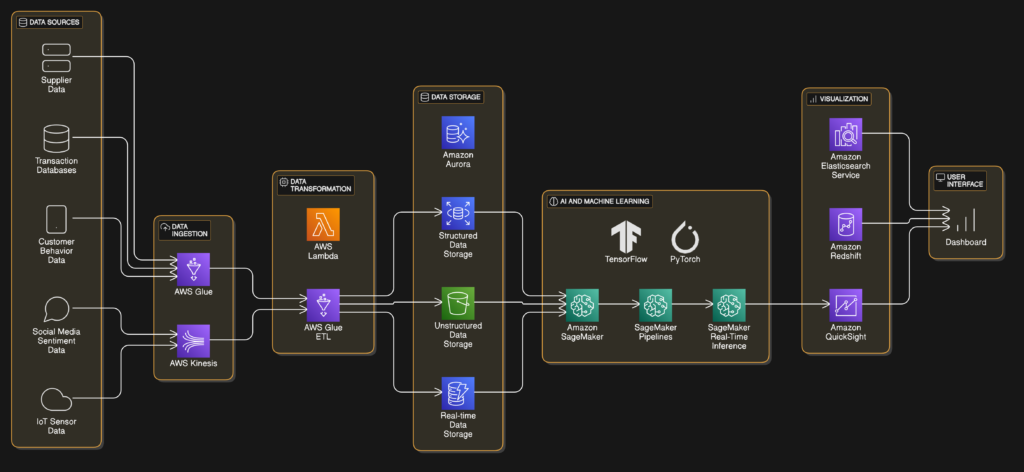AI-Driven Predictive Analytics Platform


1. Architecture Design
The architecture involves several AWS services working together to collect, process, analyze, and visualize data from various sources. Below is a breakdown of the flow:
1.1 Data Sources
The system ingests data from the following sources:
- Transaction Databases
- Customer Behavior Data
- Supplier Data
- Social Media Sentiment Data
- IoT Sensor Data
1.2 Data Ingestion
Data ingestion is handled through different mechanisms based on data type:
- AWS Kinesis ingests real-time data from Social Media Sentiment Data and IoT Sensor Data.
- AWS Glue handles batch ingestion for Transaction Databases, Customer Behavior Data, and Supplier Data.
1.3 Data Transformation
The ingested data is processed and transformed:
- AWS Glue ETL handles both structured and unstructured data transformation and prepares it for storage.
- AWS Lambda processes real-time data transformations for dynamic data.
- The transformed data is then output to the following storage options:
- Structured Data Storage (Amazon RDS or Aurora)
- Unstructured Data Storage (Amazon S3)
- Real-Time Data Storage (Amazon DynamoDB)
1.4 Data Storage
Data is stored in the following services based on its type:
- Amazon RDS: For relational data (structured data).
- Amazon S3: For raw, unstructured data.
- Amazon DynamoDB: For fast access to real-time data.
- Amazon Aurora: For high-performance relational transactional data.
1.5 AI and Machine Learning
Machine learning and AI tools are used to extract insights from data:
- Amazon SageMaker: Used for building, training, and deploying machine learning models.
- SageMaker Pipelines: Automates ML workflows.
- SageMaker Real-Time Inference: Provides real-time predictions based on trained models.
- AWS Lambda: Triggers real-time inference for immediate actions.
- Predictions are sent to Amazon QuickSight for visualization.
1.6 Visualization
Amazon QuickSight is used to visualize insights and display them on dashboards. The visualized data comes from:
- SageMaker Real-Time Inference
- Amazon Redshift
- Amazon Elasticsearch Service
1.7 User Interface
The final visualization is displayed to users through interactive dashboards powered by Amazon QuickSight, Amazon Redshift, and Amazon Elasticsearch Service.
Flow Summary:
- Data Collection > Ingested via AWS Kinesis (real-time) or AWS Glue (batch).
- Data Transformation > Processed using AWS Glue ETL and AWS Lambda.
- Data Storage > Stored in Amazon RDS, Amazon S3, Amazon DynamoDB, and Amazon Aurora.
- AI/ML > Models built and predictions made with Amazon SageMaker, using SageMaker Pipelines and Real-Time Inference.
- Visualization > Insights displayed through Amazon QuickSight, Amazon Redshift, and Amazon Elasticsearch Service on a dashboard.
This architecture ensures efficient handling of both real-time and batch data, with powerful analytics and machine learning capabilities to deliver valuable insights through an easy-to-use dashboard interface.
Goal
Your organization operates in the retail sector and wants to build a cloud-based AI-driven predictive analytics platform to improve inventory management, enhance customer experience, and optimize supply chain operations. The platform will process large volumes of structured and unstructured data collected from multiple sources, including:
- Transaction databases from various retail stores (structured data).
- Customer behavior data from the website and mobile app (semi-structured).
- Supplier data from third-party systems (structured).
- Social media sentiment data (unstructured).
- IoT sensor data from warehouses and retail outlets (real-time data streams).
The goal is to analyze this data to predict demand trends, detect supply chain bottlenecks, and personalize customer recommendations in near real-time.
Impact
The implementation of the AI-driven predictive analytics platform is expected to yield significant benefits, including:
- Enhanced Decision-Making: By providing predictive insights, the platform enables data-driven decision-making for inventory management, supply chain operations, and customer personalization.
- Improved Customer Experience: Personalized recommendations, real-time pricing, and tailored promotions enhance customer satisfaction, increasing loyalty and sales.
- Optimized Supply Chain: Predictive models help detect supply chain bottlenecks, reducing costs and ensuring timely stock replenishment.
- Operational Efficiency: Automated data ingestion, transformation, and analysis streamline workflows, reducing manual effort and improving efficiency.
- Scalability: The cloud-native architecture scales with business growth, ensuring high performance during peak periods, such as holiday seasons, while maintaining cost efficiency.
Project Overview
The project involves the development of a comprehensive AI-driven predictive analytics platform tailored for the retail sector. It encompasses the following key phases:
- Architecture Design: Establishing a scalable and efficient architecture that integrates various AWS services for data ingestion, transformation, storage, and analysis.
- Data Management: Implementing robust data ingestion and transformation processes to ensure high-quality data is available for analysis.
- AI and Machine Learning Development: Building and deploying machine learning models using Amazon SageMaker to generate predictions and insights from the data.
- Visualization and User Interface: Creating interactive dashboards with Amazon QuickSight to present insights in a user-friendly manner, facilitating easy access to critical information for decision-makers.
- Security and Compliance: Ensuring data security and compliance with industry standards through proper access controls, encryption, and monitoring.
